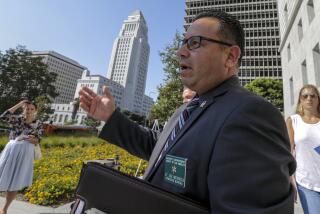Police Trading Cards a Big Hit in Small City
- Share via
SONOMA, Calif. — This is a town best known for the fruit of its fields and vineyards, for such exotic livestock as llamas and pygmy goats. The rolling hills, the ancient oaks, these have been the stars of Sonoma. Until now.
A set of 20 trading cards is turning the police force into local celebrities. Children search out officers to collect their cards. Adults just happen by when a sergeant whose card they need is on patrol.
For a small town caught in the Bay Area’s real estate boom, the cards come at a good time. Featuring photos of the officers, they help breach the arm’s-length formality of a uniform and give the police a friendly way to meet and greet the steady stream of newcomers.
“My card tells them about me, so I always ask them to tell me something about themselves--their name, what they do for a living, a good movie they saw--just something to make the conversation personal,” said Capt. Robert Wydell, whose set of Sonoma cards is augmented with several “Star Trek” characters.
“This is a small town, and the cards give us a way to have the kinds of conversations that help keep it that way,” he said. “What’s surprising to a lot of us is that people are trying to collect the whole set.”
The set covers everyone from clerk Karen Cahill to Police Chief John Gurney. Each card includes a glossy photo, the police station’s telephone number, an e-mail address and a personal message.
In the early weeks of the trading card program, collectors seemed evenly split between children and adults, Wydell said. The cards have become popular enough that the program may continue into a second year.
Trading cards first appeared in the late 1800s as a premium in some tobacco products. The trend caught on, and by the 1940s collectors could find cards to fit any interest. State capitals, famous politicians, the pyramids of Egypt, actors, animals and, of course, sports stars found their way onto the cardboard rectangles.
Sonoma’s use of law enforcement trading cards is expanding on a popular idea.
In the early 1990s, Santa Clarita and the city of Campbell, near San Jose, were among the first to use trading cards. Orange County cities including Tustin, Brea and Buena Park were quick to embrace the trend. The Los Angeles Police Department soon followed with 49 bilingual cards with traffic safety and drug prevention messages.
The newest cards, which have holograms and 3-D images, are snazzier than ever.
Cyndi Brewer, director of sales for San Dimas-based IGM/Sports Shots, takes orders for about 10 million cards each year. Her business card is a trading card.
Firefighter cards are enjoying a boom, particularly among equipment buffs who prize the photos of gleaming fire engines and firetrucks. Cards with police and fire dogs often prove more popular than those of their two-legged handlers. Photos of SWAT officers swathed in protective gear find an avid audience among boys who view them as latter-day ninja warriors.
Sometimes, invention gives way to bad judgment.
A pair of paramedics in the Bay Area community of Fremont lost their jobs over a gruesome set of so-called “death cards.” Each of the nine cards, which sold for $8.95 per pack, illustrated what the paramedics considered a stupid way to die: drinking and driving, gang activity, suicide.
A short description of each death accompanied the photos, along with a homily on how the tragedy might have been averted with “minimal common sense.” The private ambulance company that employed the men decided the paramedics themselves could use a dose of common sense, and fired them.
More to Read
Sign up for Essential California
The most important California stories and recommendations in your inbox every morning.
You may occasionally receive promotional content from the Los Angeles Times.













